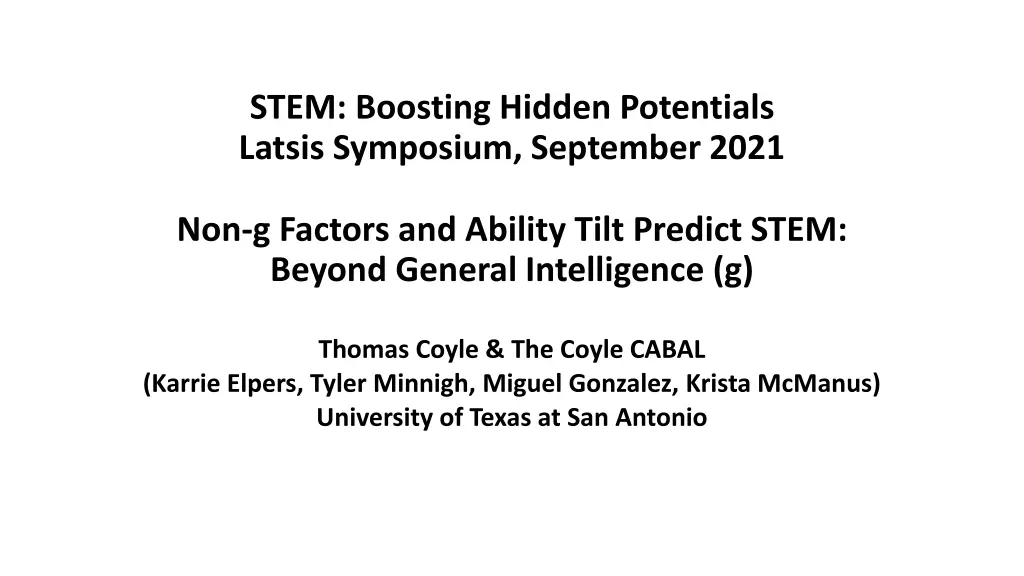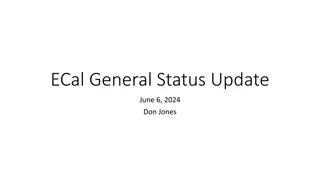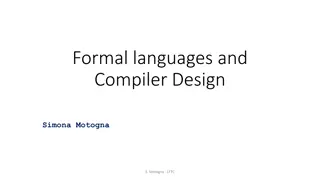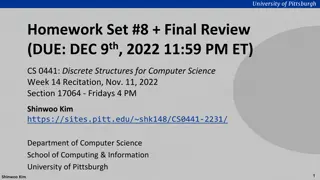
Boosting Hidden Potentials in STEM Beyond General Intelligence
Explore how non-g factors such as ability tilt and non-g residuals predict outcomes in STEM fields by challenging the primacy of g theory. The research focuses on identifying non-g factors for SAT/ACT and correlating them with GPA, college majors, and job outcomes.
Download Presentation

Please find below an Image/Link to download the presentation.
The content on the website is provided AS IS for your information and personal use only. It may not be sold, licensed, or shared on other websites without obtaining consent from the author. If you encounter any issues during the download, it is possible that the publisher has removed the file from their server.
You are allowed to download the files provided on this website for personal or commercial use, subject to the condition that they are used lawfully. All files are the property of their respective owners.
The content on the website is provided AS IS for your information and personal use only. It may not be sold, licensed, or shared on other websites without obtaining consent from the author.
E N D
Presentation Transcript
STEM: Boosting Hidden Potentials Latsis Symposium, September 2021 Non-g Factors and Ability Tilt Predict STEM: Beyond General Intelligence (g) Thomas Coyle & The Coyle CABAL (Karrie Elpers, Tyler Minnigh, Miguel Gonzalez, Krista McManus) University of Texas at San Antonio
Primacy of g Theory Primacy of g (g largely determines predictive power) Syllogism If cognitive tests are g loaded (to some degree) If g largely determines the predictive power of tests Then non-g factors of tests should have negligible predictive power Thesis: Some non-g factors have good predictive power (tilt and non-g residuals)
Coyles Challenge (Goal of My Research) To identify non-g factors with predictive power My work focuses on non-g factors for the SAT/ACT SAT/ACT correlate strongly with g (r >.80, Frey & Detterman, 2004) SAT/ACT predict GPA (r .67, Sackett & Kuncel, 2015) My research considers two non-g factors Ability tilt on SAT/ACT (math tilt and verbal tilt) Non-g residuals of SAT/ACT (math residuals & verbal residuals) Claim: Non-g factors predict STEM and other criteria!
Outline Method to study non-g factors on the SAT/ACT Studies of non-g residuals and tilt Conclusions and future research Theme: Non-g factors predict STEM and other criteria!
Approach Correlate non-g factors with outcomes in NLSY97 (N 9000) Non-g factors = ability tilt and non-g residuals (SAT/ACT) g = 12 ASVAB tests (math, verbal, speed, shop/tech) Criteria include college GPAs, college majors, jobs STEM = science, tech (computers), engineering, math Humanities = history, English, philosophy, languages
Do SAT/ACT Non-g Residuals Predict Math and Verbal Abilities? (Coyle et al. 2013, Intelligence) Correlated residuals of SAT/ACT with ASVAB abilities SAT/ACT residuals = non-g residuals of the math and verbal subtests of the SAT/ACT ASVAB abilities Math ability = math tests of the ASVAB (AR, MK) Verbal ability = verbal tests of the ASVAB (PC, WK, GS) g = all 12 ASVAB tests 6
Theory (Coyle et al. 2013, Intelligence) Theory (investment theories) Investment in a specific ability (math or verbal) boosts similar abilities but retards competing abilities Investment in math boosts math ability but retard verbal ability Predictions SAT/ACT math residuals would positively predict math ability but negatively predict verbal ability SAT/ACT verbal residuals would show opposite pattern Negative effects imply tradeoffs
Model (Coyle et al., 2013, Intelligence) u5 u6 u7 PC WK GS Verbal d2 d3 AR u8 Math MK u9 u4 SATm AO u10 u3 SATv g SAT/ACT u2 ACTm CS u11 u1 ACTr Speed d1 NO u12 d4 Shop d5 AI EI MC SI u16 u15 u14 u13 8
SAT/ACT(non-g) Residuals and ASVAB Abilities Verbal Ability Math Ability 0.40 0.30 0.20 0.10 Correlation 0.00 -0.10 -0.20 -0.30 -0.40 SATm(non-g) ACTm(non-g) SATv(non-g) ACTv(non-g) 9
Do SAT Residuals Predict STEM and Humanities GPAs? (Coyle et al. 2015, Intelligence) Correlated SAT residuals with STEM and humanities GPAs using the College Board Validity Study (N 190,000) Residuals = non-g residuals of SAT subtests (math, reading, writing) g = SAT subtests and STEM and humanities GPAs Predictions (investment theories) SAT math residualswould positively predict STEM GPAs but negatively predict humanities GPAs SAT verbal residuals (reading, writing) would show opposite pattern Negative effects imply tradeoffs 10
Model (Coyle et al., 2015, Intelligence) 11
SAT Non-g Relations and STEM / Humanities GPAs STEM Human 0.20 0.15 0.10 0.05 Correlation 0.00 -0.05 -0.10 -0.15 -0.20 -0.25 Math(non-g) Reading(non-g) Writing(non-g) 12
SAT/ACT Ability Tilt SAT/ACT ability tilt Difference in math minus verbal scores, yielding math tilt (math>verbal) and verbal tilt (verbal>math) Unrelated to g (r .00) but predicts STEM & humanities Predictions (investment theory) Math tilt would positively predict math-loaded STEM criteria but negatively predict humanities criteria Verbal tilt would show the opposite pattern (tradeoffs)
Does SAT/ACT Tilt Predict STEM Criteria? (Coyle et al. 2014, 2015, 2016) SAT/ACT tilt correlated with STEM and humanities criteria using NLSY97(N 9000) Criteria Math and verbal abilities on ASVAB College majors and jobs in STEM and humanities Predictions (investment theories) Math tilt would positively predict STEM criteria but negatively predict humanities criteria Verbal tilt would show the opposite pattern (tradeoffs) 14
Math Tilt (Higher Scores = More Math Tilt) and ASVAB Abilities SAT math tilt ACT math tilt 0.2 0.1 Correlation with Math Tilt 0 -0.1 -0.2 -0.3 Verbal Ability Math Ability Speed Ability Shop Ability 15
Verbal Tilt (Higher Scores = More Verbal Tilt) and ASVAB Abilities SAT verbal tilt ACT verbal tilt 0.3 0.2 Correlation with Verbal Tilt 0.1 0 -0.1 -0.2 -0.3 Verbal Ability Math Ability Speed Ability Shop Ability 16
Mean Tilt (M - V) for STEM and Humanities Majors (Positive Scores = Math Tilt; Negative Scores = Verbal Tilt) STEM Humanities 0.4 0.3 Mean SAT/ACT Tilt (M V) 0.2 0.1 0 -0.1 -0.2 -0.3 -0.4 Male Female
Mean Tilt (M - V) for STEM and Humanities Jobs (Positive Scores = Math Tilt; Negative Scores = Verbal Tilt) STEM Law/Media/Counseling 0.6 0.5 0.4 Mean SAT/ACT Tilt (M V) 0.3 0.2 0.1 0 -0.1 -0.2 -0.3 -0.4 -0.5 SAT tilt ACT tilt PSAT tilt
Summary Tilt and non-g factors predict STEM and humanities (abilities, GPAs, majors, jobs) Tilt effects obtained after controlling for g! Effects consistent with investment theories
Questions Does tilt increase over time with ability specialization (investment theories)? Are tilt effects stronger at higher ability levels (SLODR)? Are tilt effects obtained for other abilities such as spatial ability (ASVAB: MC, AO)?





















